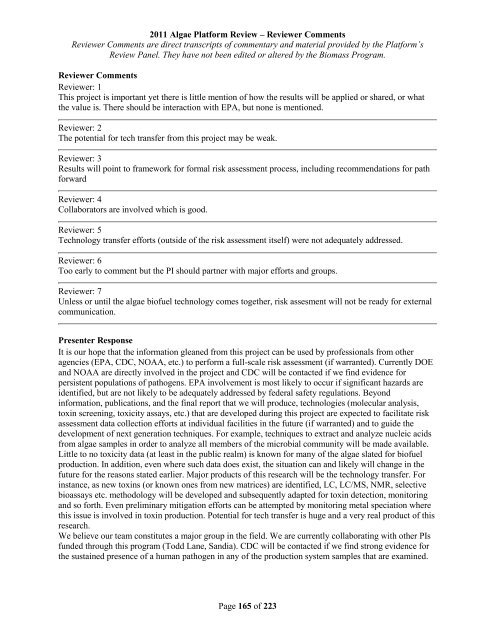Reviewer Comments - EERE
Reviewer Comments - EERE
Reviewer Comments - EERE
You also want an ePaper? Increase the reach of your titles
YUMPU automatically turns print PDFs into web optimized ePapers that Google loves.
2011 Algae Platform Review – <strong>Reviewer</strong> <strong>Comments</strong><br />
<strong>Reviewer</strong> <strong>Comments</strong> are direct transcripts of commentary and material provided by the Platform’s<br />
Review Panel. They have not been edited or altered by the Biomass Program.<br />
<strong>Reviewer</strong> <strong>Comments</strong><br />
<strong>Reviewer</strong>: 1<br />
This project is important yet there is little mention of how the results will be applied or shared, or what<br />
the value is. There should be interaction with EPA, but none is mentioned.<br />
<strong>Reviewer</strong>: 2<br />
The potential for tech transfer from this project may be weak.<br />
<strong>Reviewer</strong>: 3<br />
Results will point to framework for formal risk assessment process, including recommendations for path<br />
forward<br />
<strong>Reviewer</strong>: 4<br />
Collaborators are involved which is good.<br />
<strong>Reviewer</strong>: 5<br />
Technology transfer efforts (outside of the risk assessment itself) were not adequately addressed.<br />
<strong>Reviewer</strong>: 6<br />
Too early to comment but the PI should partner with major efforts and groups.<br />
<strong>Reviewer</strong>: 7<br />
Unless or until the algae biofuel technology comes together, risk assesment will not be ready for external<br />
communication.<br />
Presenter Response<br />
It is our hope that the information gleaned from this project can be used by professionals from other<br />
agencies (EPA, CDC, NOAA, etc.) to perform a full-scale risk assessment (if warranted). Currently DOE<br />
and NOAA are directly involved in the project and CDC will be contacted if we find evidence for<br />
persistent populations of pathogens. EPA involvement is most likely to occur if significant hazards are<br />
identified, but are not likely to be adequately addressed by federal safety regulations. Beyond<br />
information, publications, and the final report that we will produce, technologies (molecular analysis,<br />
toxin screening, toxicity assays, etc.) that are developed during this project are expected to facilitate risk<br />
assessment data collection efforts at individual facilities in the future (if warranted) and to guide the<br />
development of next generation techniques. For example, techniques to extract and analyze nucleic acids<br />
from algae samples in order to analyze all members of the microbial community will be made available.<br />
Little to no toxicity data (at least in the public realm) is known for many of the algae slated for biofuel<br />
production. In addition, even where such data does exist, the situation can and likely will change in the<br />
future for the reasons stated earlier. Major products of this research will be the technology transfer. For<br />
instance, as new toxins (or known ones from new matrices) are identified, LC, LC/MS, NMR, selective<br />
bioassays etc. methodology will be developed and subsequently adapted for toxin detection, monitoring<br />
and so forth. Even preliminary mitigation efforts can be attempted by monitoring metal speciation where<br />
this issue is involved in toxin production. Potential for tech transfer is huge and a very real product of this<br />
research.<br />
We believe our team constitutes a major group in the field. We are currently collaborating with other PIs<br />
funded through this program (Todd Lane, Sandia). CDC will be contacted if we find strong evidence for<br />
the sustained presence of a human pathogen in any of the production system samples that are examined.<br />
Page 165 of 223




